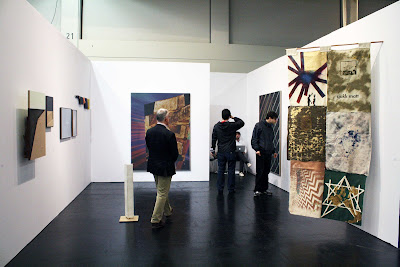Currently living and working in Montreal, Jackson Slattery held his second solo exhibition at Sutton Gallery in August.
Your current exhibition at Sutton Gallery in Melbourne, Wrong Formalism, is process driven; focusing on the surface of the painting and the formal composition of painting. Have you always been interested in exploring formalism?
Your current exhibition at Sutton Gallery in Melbourne, Wrong Formalism, is process driven; focusing on the surface of the painting and the formal composition of painting. Have you always been interested in exploring formalism?
For this particular exhibition I really wanted to reduce my practice to its bare essentials. My aim was to create a body of work that used formal elements to create a sense of time and narrative. I'd recently read an interview with Gerhard Richter and the interviewer asked him whether it was possible to create an abstract work that dealt with narrative. Whilst he cleverly evaded the question I really liked the idea of these binary elements somehow coming together. From that point my intention was to find a common ground between my particular painting approach and formalism.
These
works have an abstract quality that I have not seen in your previous
watercolours. Can you tell us a little about how this project differs
from previous shows?
I figured that if I wanted to reduce time and narrative down then I'd have to erase subject matter. I bought a couple of pieces of safety glass and carried them around with me for almost a year. I chose safety glass specifically because I wanted to essentially erase the subject matter by using a semi-transparent glass and abstracting any objects which might be behind the glass. I also grabbed an fake Ikea rose to help establish formal compositions. The choice of the rose was mainly arbitrary though it interested me to use such a romantic prop to create such specifically cold and emotionless "formalist" works. My intention was to photograph those pieces of glass and the rose in all the countries that I visited that year. As a result, I was left with images conveyed time only though formal suggestions, such as light, colour and composition.
I figured that if I wanted to reduce time and narrative down then I'd have to erase subject matter. I bought a couple of pieces of safety glass and carried them around with me for almost a year. I chose safety glass specifically because I wanted to essentially erase the subject matter by using a semi-transparent glass and abstracting any objects which might be behind the glass. I also grabbed an fake Ikea rose to help establish formal compositions. The choice of the rose was mainly arbitrary though it interested me to use such a romantic prop to create such specifically cold and emotionless "formalist" works. My intention was to photograph those pieces of glass and the rose in all the countries that I visited that year. As a result, I was left with images conveyed time only though formal suggestions, such as light, colour and composition.
You
have a sculptural practice that is not present in this current
exhibition. Can you share with us your interest in sculpture and whether
it has a direct relationship to your 2D practice or runs along side of
it?
For
the last couple of years I've been making sculptural works to coincide
with my 2D practice although for this show I really wanted to strip as
much back as possible. That meant both conceptually and physically. I
really wanted to see if the paintings could hold their own and not have
to rely on 3D works.
You have been living in Montreal for the past few years, has this changed your practice?
It's difficult to gauge how Montreal has affected my practice. Practically speaking, I don't have the extended support network that I had in Melbourne which is both good and bad. It forces me to scrutinize my work more thoroughly than before because I can't as easily bounce my ideas off other people.
What has been the most exciting this you have see in art this year?
Alex Vivian, Campbell Patterson and Kieren Seymour are all making pretty incredible work.
What are you looking forward to in the next 12 months?
What are you looking forward to in the next 12 months?
Next up are some group shows in Melbourne and Vienna, and then I'm off to New York at the beginning of 2013 for the ISCP residency.
All images courtesy Jackson Slattery and Sutton Gallery
All images courtesy Jackson Slattery and Sutton Gallery








































